Ata-ul-Haye Nasir, Al Hakam
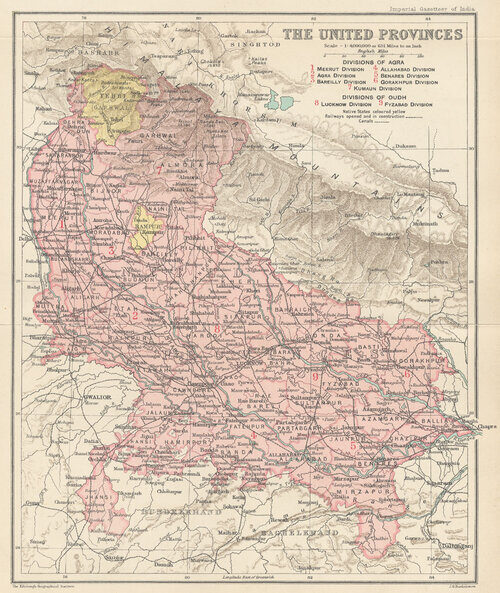
The background of Shuddhi Movement
The founder of the Arya Samaj, Swami Dayanand Saraswati (1824-1883) had initiated the Shuddhi Movement to convert Indian Muslims and Christians to Hinduism.
This movement got stronger during the early twentieth century, under the leadership of Swami Shraddhanand (1856-1926), a follower of Dayanand.
The Aryas “started a campaign of reclaiming the Malkana Rajputs, Jats, and Gujar Mussalmans of Meerut, Agra, Mathura, Mainpuri, Etah, Etawah, in the then United Provinces and Karnal, Ambala, Rohtak and Hissar in the then Punjab.” (Shuddhi Movement in India: A Study of its Socio-political Dimensions, by RK Ghai [ed. 1990], p. 97)
The Aryas would tell them that the Muslim rulers had forcefully converted their Hindu ancestors to Islam, and now they should re-join their ancestors’ religion. Secondly, they would present a wrong image of Islam and raise objections against Islamic teachings. As Islamic teachings had not yet completely been instilled within those Muslims – and many were not practising the fundamentals of Islam and retained their past Hindu beliefs – they were an easy target for this movement.
“Writing about the increase in the members of the Arya Samaj in the U.P., a Census Report says that the number of Aryas of this province grew from 65,572 in 1901 to 131,638 in 1911 due to shuddhi movement. […] Since numbers had become a significant factor in the wake of the Act of 1909 which granted communal representation to Muslims, the Arya Samaj took a keen interest in converting the Muslim Rajputs who had only recently changed their faith and were retaining many of the Hindu social and religious practices in their life and culture.” (Shuddhi Movement in India: A Study of its Socio-political Dimensions, by RK Ghai [ed. 1990], p. 75)
Amidst the increasing impact of the Shuddhi Movement, the Indian Muslim leaders felt the need for a joint effort to tackle this issue. In April 1912, while Hazrat Sahibzada Mirza Bashiruddin Mahmud Ahmadra was in Lucknow, Allama Shibli Nomani – a prominent Muslim leader – invited him to attend the Annual Conference of the Nadwat-ul-Ulama, which was held on 6-8 April 1912.
In this regard, Syed Sulaiman Nadvi writes:
“Maulana [Shibli Nomani] wanted that all sects should unitedly work for the propagation [of Islam]. For this reason, he did not even deny the participation of Mirza Bashiruddin Mahmud Ahmad Sahib – who is the current Khalifa of Qadian – and Khawaja Kamaluddin Sahib. Upon this, Maulana was questioned during the same jalsa as to why he had invited Qadianis to this jalsa, and allowed them to deliver speeches.” (Hayat-i-Shibli [ed. 1970], p. 571)
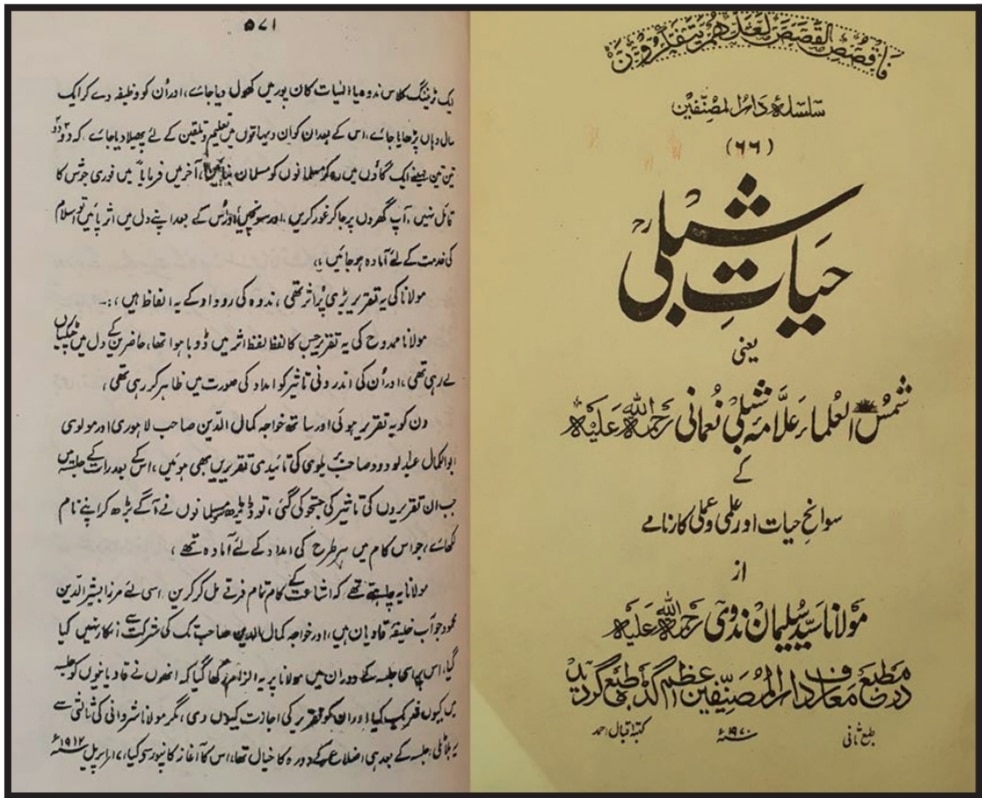
Unfortunately, in such circumstances, the plans that were proposed during the jalsa could not work in the long term.
In March 1923, Swami Shraddhanand appealed to the Hindus for funds, and stated that the Malkana Rajput, Gujjar and Jat communities were being converted to Hinduism (from Islam) with great speed around Agra. He added:
“Such people are found in all parts of India. They are no less than five to six million. And if the Hindu society continues to absorb them within itself, then I would not be surprised if their numbers reach 10 million.” (Pratap of Lahore, 16 March 1923, p. 4)
According to the Indian Newspaper Reports (INR), The Shanti of 4 March 1923 “asks the Hindus to help the Bharat Hindu Shuddhi Sabha with men and money in the work of bringing Muhammadan Rajputs into the Hindu fold.” The INR further reported that “Ram Partap Gopal, a member of the Hindu Sabha of Ludhiana (now residing at Agra), writing to the Partap of the 4th March requests all Hindus promptly to help the Bharat Shuddhi Sabha with funds.“
This reports continued by stating:
“The Zamindar of the 6th March says that all possible efforts should be made to save the Muslim Rajputs of the United Provinces from abjuring Islam.
“A correspondent writing to the Zamindar of the 7th March avers that the forcible conversion of Mussalmans to the Arya faith will prove most injurious to the interests of Hindu-Muslim unity.“
This report then quotes The Muslim Outlook of 11 March 1923 which wrote, “The dilatoriness displayed by Muslims in the matter of Rajput apostasy is most disgraceful. While Hindus, both orthodox and heterodox, are straining every nerve to bring the Rajputs into their fold, the Mussalmans are still occupied with concerting measures only. … Threats of eviction of Malkanas who are in the clutches of Hindu banias and of violence to the Mussalman preachers who try to approach their co-religionists are being freely resorted to and to add insult to injury, now lies have begun to be telegraphed to the effect that it is the Mussalmans who are threatening violence.” (Punjab Press Abstract, Vol. XXXVI, No. 11, 17 March 1923, p. 145)
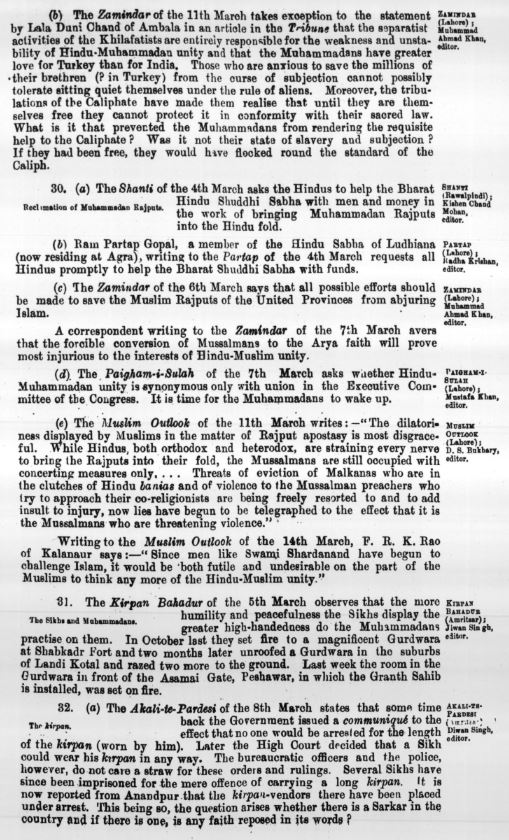
According to The Calcutta Samachar of 30 March 1923, about 7,000 Malkanas had converted to Hinduism from Islam by that time.
Many Hindu organisations “sanctioned the shuddhi programme of the Samaj”, and the UP Social Conference also passed the following resolution on 24 August 1923:
“This conference accords its whole-hearted support to the Shuddhi Movement now in progress in different parts of the country.” (Shuddhi Movement In India: A Study of its Socio-political Dimensions, by R.K. Ghai [ed. 1990], p. 96)
The Ahmadiyya response to the Shuddhi Movement
As for the Ahmadiyya response, we find an official report from the India Office in London to the Home Department of the Indian Government, dated 3 September 1924, mentioning the response from the Indian Muslims. This report stated:
“The Ahmadi Sect readily lent their powerful support and were the first in the field. They soon claimed easy victories.” (National Archives of India, Home Department, Political, 1924, File No. 6/IX)
Moreover, R.K. Ghai has written that “these large scale efforts of converting Muslims caused immediate reaction of the Muslim organizations, like the Ahmadiyas of Qadian.” (Shuddhi Movement In India: A Study of its Socio-political Dimensions, [ed. 1990], p. 97)
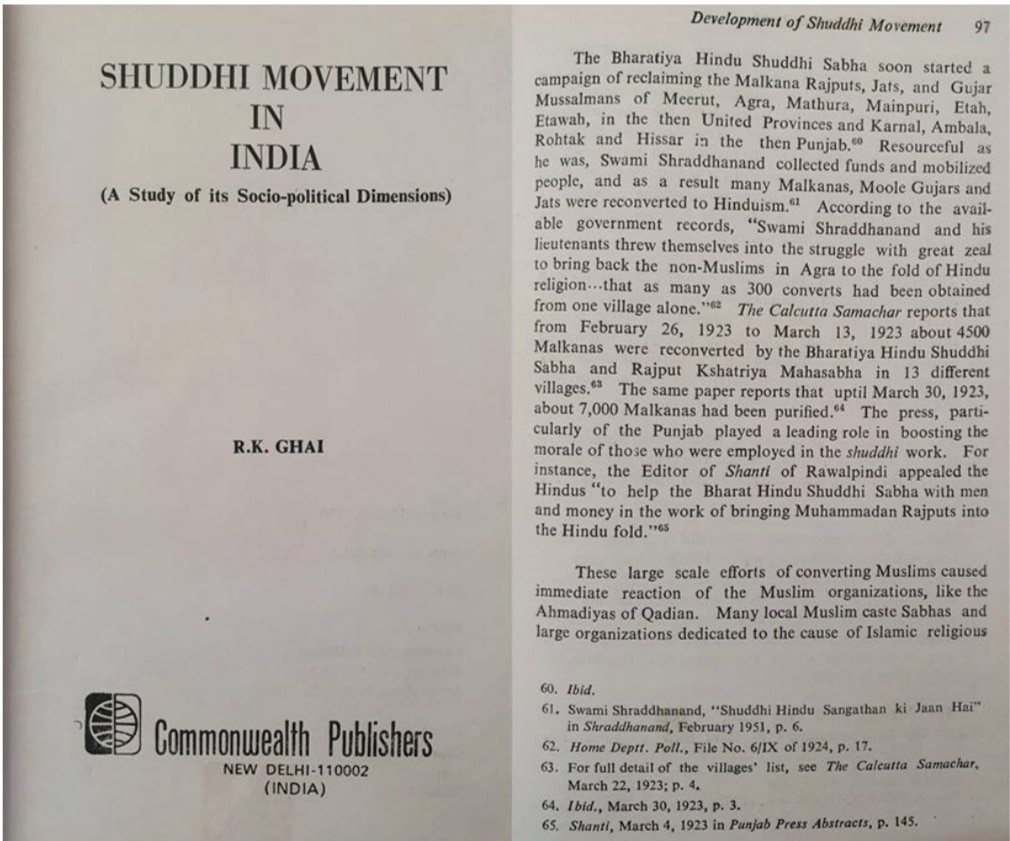
On 7 March 1923, before delivering a dars (sermon) on the Holy Quran, Hazrat Musleh-e-Maudra said:
“During my recent Friday Sermons, I have delivered speeches, especially on the topic that the level of sincerity, sacrifice for religion and selflessness which is present in our Jamaat, is found nowhere else. And I truly expressed a hope that if the members of our Jamaat needed to sacrifice their lives for Islam, they would not stay behind. My hope was neither without reason, nor without need. […]
“The need that had been under my consideration for the last month or so, which I was pondering on, is the irtidad [apostasy] that has begun in UP [United Provinces]. The Arya had started a campaign to gradually spread apostasy within a community, which is around 450,000 [in numbers]. And the situation has reached such an extent that it is expected that all those people will convert to Arya [Samaj]. […]
“A person who returned today from a visit to that area, reported that their situation is such that when some people wanted to visit a village to make them understand [the truth], they conveyed to them that anyone who comes here would be killed.” (Al Fazl, 12 March 1923, p. 13)
Huzoorra said that he had made a scheme to tackle this issue, which would be announced during the upcoming Friday Sermon. He added that members of the Jamaat, especially those who lived in the markaz, should be ready to offer any kind of sacrifice, and for our Jamaat, this was the first opportunity of its kind.
On 8 March 1923, the newspaper Vakil of Amritsar wrote an article titled “Ulema-e-Islam Kahan Hain?” (Where are the Scholars of Islam?) wherein the Muslim ulema and leaders were addressed. While addressing Hazrat Musleh-e-Maudra, they raised a question as to why he was silent on the issue of the Shuddhi Movement.
In response, on 9 March 1923, Huzoorra wrote an article titled “Saarhay Chaar Lakh Musalman Irtidad Ke Liay Tayyar Hain – ‘Vakil’ Amritsar Ki Da‘wat Ka Jawaab” (450,000 Muslims are on the verge of apostasy – Response to the invitation of Vakil of Amritsar).
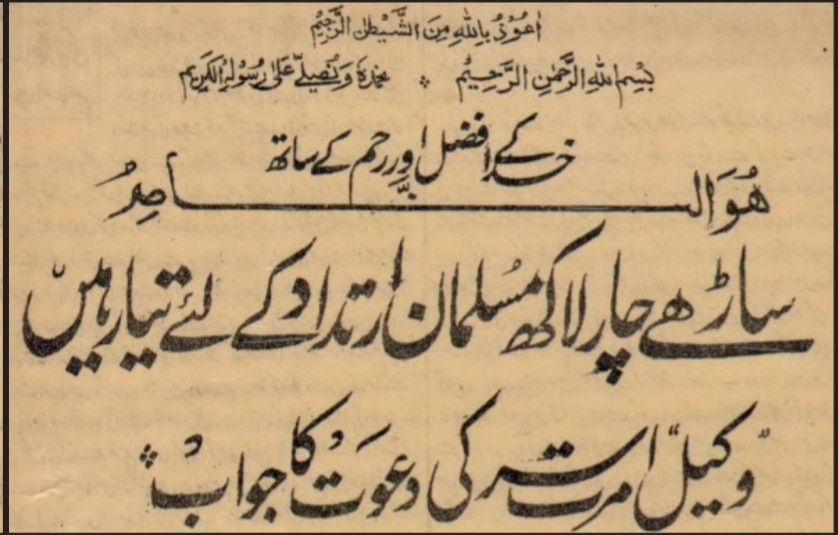
After mentioning the article of Vakil, Huzoorra said:
“I deem it appropriate to eradicate the misconception which has penetrated the heart of the editor of Vakil, and to respond to those matters which have been linked to us by the Daily Vakil, without any thought. The moment I came to know that a whole community is on the verge of apostasy, instantly I instructed my office to investigate this matter thoroughly. […] Therefore, the news was authenticated through different sources, and after having necessary details, two persons were sent there in February [1923] to perform initial research. […] After receiving their report that the situation is very delicate there, and immediate action is required, I have drafted a scheme through which we can hope for the success, illaa masha-Allah. From these happenings, the editor of Vakil would have known that our Jamaat did not remain silent, neither was I neglectful about this fitna. We have already sent two persons, and vast arrangements are being made for the future as well.” (Al Fazl, 12 March 1923, p. 7)
Huzoorra stated that he was happy the Vakil had shown an interest in the propagation of Islam, but regretfully it ignored the Jamaat’s services for Islam and gave the impression that we were indifferent about this duty, just like the other Muslims.
Huzoorra further stated:
“With regard to the implementation of this scheme, there are some hurdles in front of us. We have not yet fully begun this work, and the matter which is preventing us from doing this is that when our volunteers commence the field work, all other Muslims will start opposing us instead of tackling the [issue of] Malkanas. […] I am not saying this without reason; instead, vast experience bears witness to this.” (Al Fazl, 12 March 1923, pp. 8-9)
Huzoorra then narrated some incidents where non-Ahmadi Muslims created disorder when Ahmadis were preaching Islam to the Christians and Hindus.
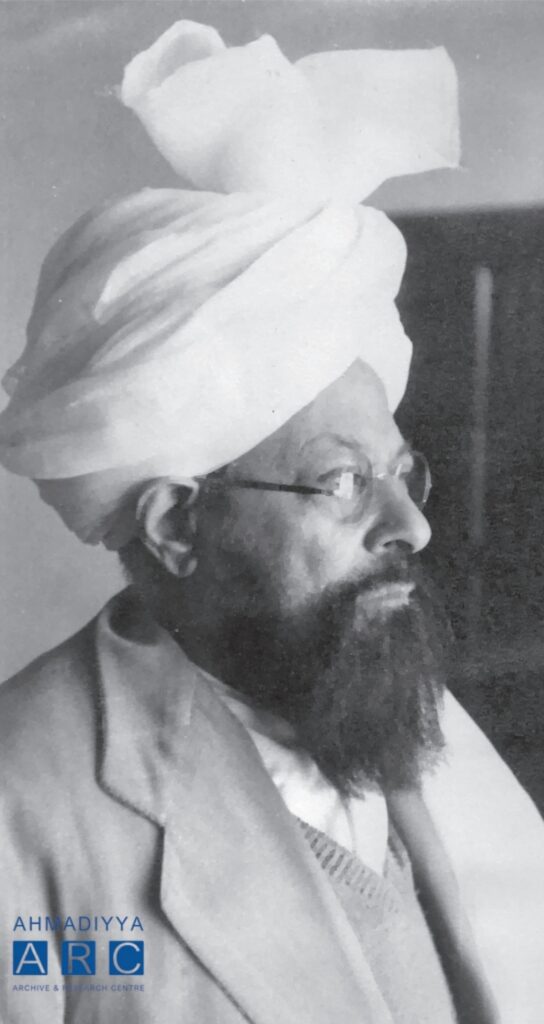
Huzoorra continued:
“We do not fear the afflictions. We do not care about the enmity. When did we ever care about the opposition from any maulvi, sajjada nashin or leader, that we will care about it now? However, the current situation is very delicate. […] I request the educated people that if they really consider the importance of this matter, they should find the solution for this problem; otherwise, in case the maulvi sahiban make any disorder, then the responsibility will be on their shoulders. Despite this, we will achieve great success, insha-Allah, but it will severely harm the cause [collectively].” (Al Fazl, 12 March 1923, p. 10)
Huzoorra stated that it should not be thought that this campaign by the Aryas would only be limited to the Malkana people, instead nearly 10 million Muslims were in danger according to their plans.
Huzoorra continued:
“Muslims should not assume that they would easily stop these communities from apostasy. [The Aryas] were exerting efforts through some invalid and secret ways among these communities, and now Hindu beliefs are common within these communities. […] Until there is a continuous and proper struggle, it is meaningless to hope for success in these areas. There would be huge expenditures as well for this task […] Despite their previous efforts, Hindus are demanding a million rupees [for the Shuddhi Movement]. Muslims need an amount of two million rupees to initiate this new task. […]
“I am ready to offer any kind of assistance, with the help of Allah the Almighty. Our Jamaat is small and [financially] weak as well. In India, 80 million people claim to be Muslims. Even if our Jamaat is supposed to be 500,000 in India, our contribution should be 1/160 of the two million rupees, meaning 13,000 rupees. […] I promise that we will raise an amount of 50,000 rupees, insha-Allah, which would be 1/40 of the total amount, provided the remaining amount is collected by the other [Muslims].” (Al Fazl, 12 March 1923, p. 11)
Huzoorra added that the Jamaat would provide 30 people for preaching as well, whose expenditure would be provided by the Jamaat itself, and if needed, hundreds of such Ahmadis would be provided.
During his Friday Sermon on 9 March 1923, after narrating the background of the Shuddhi Movement and apostasy in Malkana area, Huzoorra stated:
“Until and unless we sacrifice our desires, business, comfort, life and wealth, this task cannot be accomplished. Those [members] should come forward who are ready to present every kind of sacrifice and have the will and determination that they will accomplish this task at any cost, insha-Allah. And their situation should be: ‘Either I accomplish the task and convince others, or sacrifice myself while striving [for the cause].’” (Al Fazl, 15 March 1923, p. 4)
Huzoorra said that around 150 passionate volunteers were needed to work in the Malkana area, and they would have to dedicate themselves for three months.
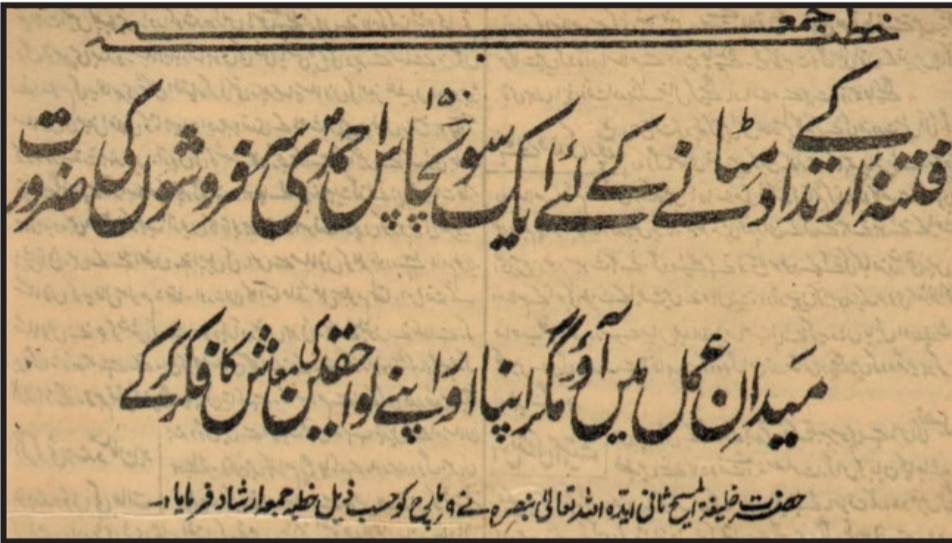
Huzoorra then outlined the conditions for this dedication, such as they would not be provided any allowance for their travel fares, residence costs and food etc. and would have to bare the expenses of their families as well for the three-month period. However, the postage and tabligh (preaching) expenses would be provided by the markaz.
Huzoorra said that those who would be sent by the markaz to make arrangements there, would get a third class fare and very minimal amounts for their expenses. Huzoorra said that for these expenditures, members of the Jamaat would need to donate 50,000 rupees.
Huzoorra continued:
“Remember that the Promised Messiahas is not only the Messiah and Mahdi, but also the [second coming of] Krishanas. This means that he was a reformer for the Hindus as well. Now, we will start preaching to them as well, and until we do not preach to the Hindus, how can we prove the Promised Messiahas to be the [second coming of] Krishanas.
“The Promised Messiahas is the Messiah, so his Jamaat will be victorious over the Christians. He is the Mahdi, so the Muslims will get guidance from him again. He is [second coming of] Krishanas, so his Jamaat will be victorious over the Hindus, and will be widely accepted. For us, the avenues are opening for spreading the truth. We will make efforts [to spread Islam] amongst the Hindus.” (Al Fazl, 15 March 1923, p. 6)
On 12 March 1923, after the Fajr prayer, Huzoorra delivered a short speech in which he stated that in response to his call, around 70 applications had already been received. He said that after reading the Arya newspapers the night before, he had come to know that they were swiftly working to achieve their goal.
Huzoorra said he intended to begin the scheme from 1 April 1923 and instructed Hazrat Chaudhry Fateh Muhammad Sayalra to visit the Malkana area on 12 March, but then decided to send more people along with him so they could learn to work as per the local circumstances. (Al Fazl, 15 March 1923, p. 1)
On Huzoor’s instructions, a new office with the name “Insidad-e-Irtidad-e-Malkana” [Prevention to the apostasy of Malkana] was opened, and Hazrat Mirza Bashir Ahmadra MA was appointed as its head, while Hazrat Mirza Sharif Ahmadra and Hazrat Nawab Muhammad Abdullah Khanra were appointed as the deputies.
Huzoorra appointed Hazrat Chaudhry Fateh Muahmmad Sayalra as the amir-ul-mujahideen (in-charge of the missionaries), and sent the first delegation of 20 missionaries under his leadership on 12 March 1923, which reached Agra on 14 March. (Al Fazl, 15 March 1923, pp. 1-2)
They set Agra as their base of operations and sent the missionaries to the surrounding areas, such as Mainpuri, Etah, Farrukhabad and Aligarh. They assessed the situation in those areas and started their missionary work.
In response to Hazrat Musleh-e-Maud’s call, members of the Jamaat showed a great spirit of obedience and sacrifice. Nearly 1,500 Ahmadis presented themselves for the service of Islam, which included lawyers, traders, landowners, industrialists, teachers, students, employees, labourers and Arabic and English speaking people. These people included men, women, elders and children as well. (Tarikh-e-Ahmadiyyat, Vol. 4, p. 333)
A newspaper, Hamdam, on 18 March 1923, wrote that by witnessing Jamaat-e-Ahmadiyya’s passion and spirit of sacrifice, it was almost certain they would raise 50,000 rupees or even more, but expressed hopelessness for such a sacrifice from the non-Ahmadi Muslims.
In addition to the 50,000 rupees, members of the Jamaat also donated bicycles and sunlight protectors for the volunteers. On the occasion of Eid-ul-Adha, thousands of rupees were raised to sacrifice animals for the Malkana community. Some Ahmadis made donations by even selling their animals or houses, and members of Lajna Imaillah donated veils for Malkana women. (Ibid, p. 334)
A newspaper, Mashriq of 15 March 1923, stated:
“The selflessness and concern with which Jamaat-e-Ahmadiyya carries out its efforts in preaching and propagating Islam cannot be seen in other communities these days.”
On 24 March 1923, Hazrat Chaudhry Fateh Muhammad Sayalra sent a telegram to the markaz requesting 20 more missionaries. Thus, a delegation of 22 missionaries departed from Qadian on the same day (Al Fazl, 29 March and 2 April 1923).
Before the departure of this delegation, Hazrat Musleh-e-Maudra delivered a speech at the Mubarak Mosque, and shed light on the need for sacrifice for the propagation of Faith. (Al Fazl, 2 April 1923, pp. 1-2)
The delegation reached there on 26 March 1923, and on the same night, Hazrat Chaudhry Fateh Muhammad Sayalra gave them a briefing about the plan of action, and sent them to different areas the next day. (Tarikh-e-Ahmadiyyat, Vol. 4, p. 356)
The newspaper, Mashriq wrote on 29 March 1923:
“The continuous speeches and writings of the Imam and Head of Jamaat-e-Ahmadiyya have a great impact on his followers, and we witness this very sect at the forefront of this jihad [tabligh in the Malkana area].”
On 1 April 1923, a Hindu newspaper, Arya Patrika of Bareli, reported:
“The activities and efforts of the Ahmadiyya Jamaat of Qadian are really commendable amongst the Muslim anjumans and communities which are striving to prevent the Malkana Rajputs […] from rejoining their forefathers’ community [Hinduism].”
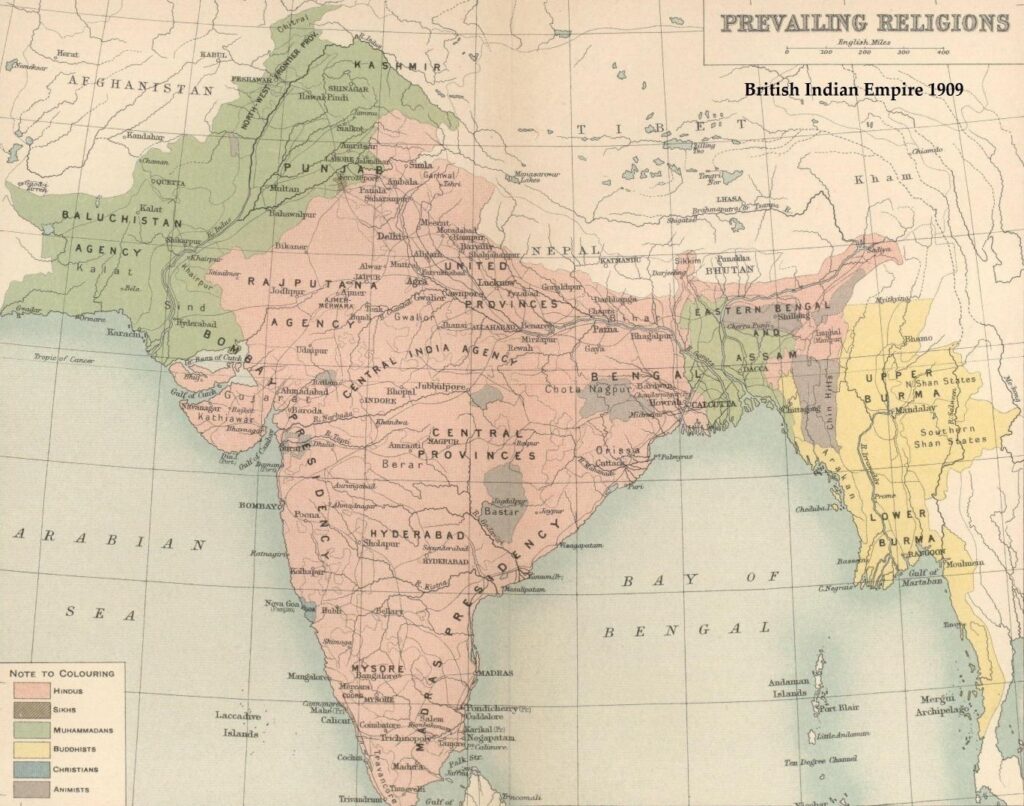
On 4 April 1923, the third delegation of 22 missionaries departed from Qadian, and reached Agra on 6 April. (Al Fazl, 9 and 12 April 1923)
According to the Indian Newspaper Reports, The Muslim Outlook of 5 April 1923 wrote:
“The Bharatpur authorities have expelled from the State two Ahmadi preachers who had gone there to avert perversion. The Maulvis, it is to be noted, belong to the Qadiani sect, which is well-known for its support of law and order, and no amount of explanation can make one believe that the preachers’ presence in the State would have produced the slightest disturbance of public tranquillity. Thus the door has been shut against Muslims who would take defensive measures against the ‘Shuddhi’ propaganda in Bharatpur. This is neither just nor fair; nay, it is intolerable. We draw the attention of the Government of India to the matter and request it to take prompt action to redress this Muslim grievance.” (Punjab Press Abstract, Vol. XXXVI, No. 15, 14 April 1923, p. 200)
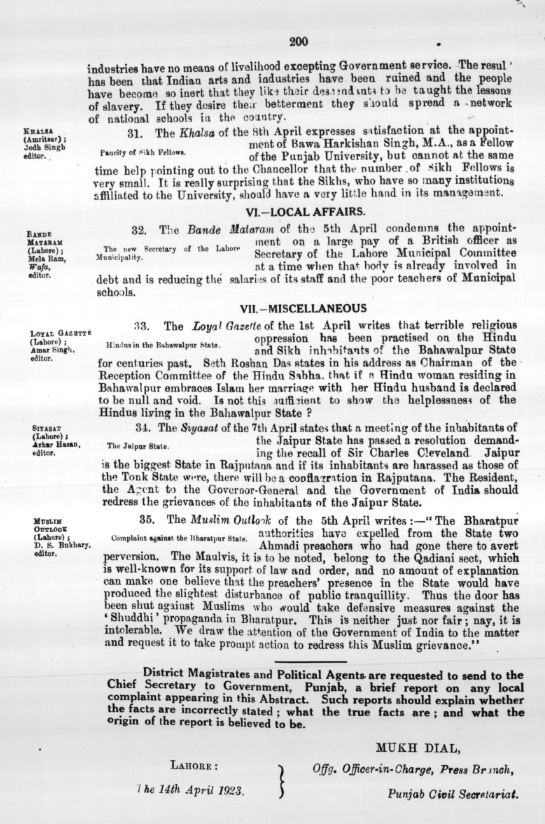
On 8 April 1923, a Muslim newspaper, Zamindar wrote:
“The Ahmadi brothers have participated in this work [of preaching Islam] with such sincerity, sacrifice, passion and concern, that every Muslim should take pride in it.”
On 16 April 1923, the fourth delegation consisting of 19 missionaries departed from Qadian. (Al Fazl, 19 April 1923, p. 1)
On 21 April 1923, Huzoorra issued detailed guidelines for the missionaries who were serving in the Malkana area, in which Huzoorra instructed them to pay special attention towards prayers (dua), and the recitation of Surah al-Fatihah and durood sharif. Moreover, he advised them to learn the local language of that area for effective preaching, and to learn the answers for the allegations raised against Islam by the Arya Samaj. Huzoorra instructed that at first, they should get all the necessary information related to the area where they were deployed, and make good relations with the local officials. He advised to practise high morals, simplicity and to serve those in need. Huzoorra stated that the Ahmadi missionaries should regularly send reports of their activities, as it was equally important to make the markaz aware of their progress. (Tarikh-e-Ahmadiyyat, Vol. 4, pp. 341-351)
A Hindu newspaper, Jeevan Tat of Lahore, wrote on 24 April 1923:
“The Ahmadis are expressing great passion to prevent the Shuddhi [purification] of Malkana Rajputs and to preach them the religion of Islam.”
Another newspaper, Najaat of Bajnur, stated on 27 April 1923:
“The Qadiani Jamaat has such religious love and passion for the Muslims that their 150 missionaries are working [in the Malkana area] for a period of three months without any allowance, and bearing the expenditures themselves, and 200 more missionaries are ready to do so.”
When the missionaries would come back to Qadian after completing the duration of their dedication, Huzoorra would grant them a certificate of acknowledgement in order to appreciate their efforts. (Tarikh-e-Ahmadiyyat, Vol. 4, pp. 374-375)
On 1 May 1923, a newspaper, Rozgar of Agra stated:
“Undoubtedly, the Jamaat of Qadian is at the forefront amongst all the delegations, religious speakers and supporters of Islam which are striving [against the Shuddhi Movement]. We express our gratitude to their religious speakers who are working despite facing all kinds of afflictions and problems.”
The Muslim newspaper, Vakil of Amritsar, on 3 May 1923, stated:
“The approach of the Ahmadi Jamaat is highly commendable that despite the incitement [from the non-Ahmadi Muslims], they are ever ready to work in any circumstances, with the aim to save Islam from any kind of affliction. […] On the basis of our observation, we declare that the Ahmadi Jamaat of Qadian is doing the best work.”
The Ahmadi missionaries were severely opposed by the Aryas and the non-Ahmadi Muslims as well, even they faced opposition from the local police as well, but they continued with great passion of sacrifice and dedication. The Muslims who had converted to Hinduism under the influence of the Shuddhi Movement, re-joined Islam in large numbers. (Tarikh-e-Ahmadiyyat, Vol. 4, pp. 385-387)
Sheikh Ghulam Hussain, a non-Ahmadi from Jhelum, wrote a letter to the Zamindar newspaper:
“The Qadiani Ahmadis are displaying great selflessness. Approximately a hundred of their preachers, under the command of the delegation’s head, are stationed in various villages. These people have rendered a visible service. All these preachers are working without pay or stipends. Although we are not Ahmadis, we cannot refrain from praising the great work of the Ahmadis. The selflessness that has been shown by Jamaat-e-Ahmadiyya cannot be seen anywhere except in the likeness of the early Muslims.” (Zamindar, 29 June 1923)
On 19 August 1923, Swami Shraddhanand invited all the Muslims for a debate in order to distract them from their practical efforts against the Shuddhi Movement. Although he did not mention Jamaat-e-Ahmadiyya, as he had challenged the Muslims as a whole, thus the nazir talif-o-ishaat [publications] of Qadian sent him a telegram and stated that Jamaat-e-Ahmadiyya accepted his challenge for a debate, despite the fact that the conditions of the debate were unjust. (Tarikh-e-Ahmadiyyat, Vol. 4, pp. 388-389)
The All India National Congress called a special session in regard to the Shuddhi and Sangathan movements, in which the president of the Congress, Abul Kalam Azad appealed to all the Indian Muslims and Hindus to make peace.
After his address, a conference of Muslim and Hindu leaders was held and an Ittehad (Unity) Committee was established, which included Muslim and Hindu leaders. The members of this committee agreed to stop the activities of the Shuddhi Movement and the defence by the Muslims, and let the Malkana community decide themselves about their future. As Swami Shraddhanand was also a member of this committee, he used this as an excuse to withdraw his challenge for the debate. (Ibid, p. 390)
When the news of this agreement reached Hazrat Musleh-e-Maudra, he instructed the nazir insidad-e-irtidad (prevention to the apostasy) department, Hazrat Mirza Bashir Ahmadra MA to send a telegram to the Muslim members of the Ittehad Committee. The telegram stated that this agreement was unwise and against the Muslim interests, and as the Aryas were actively working there for a long time, quitting Islam’s preaching would mean to let those people remain as Hindus. (Ibid, pp. 391-392)
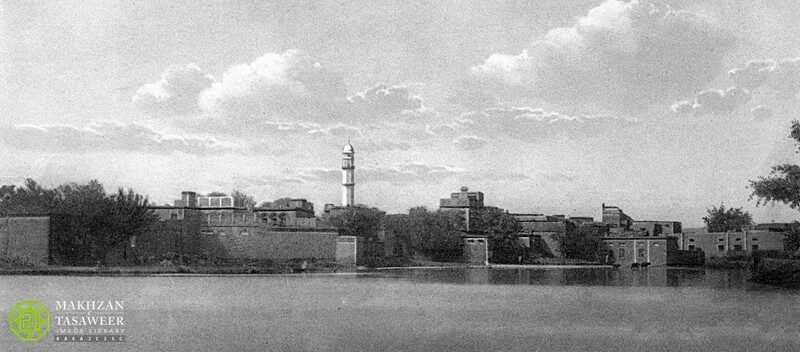
When this telegram reached there, the committee had already decided that both the Muslims and Arya preachers would leave the Malkana area, but the only question was as to who would leave first.
The Muslim members agreed that their preachers would leave first, but Swami Shraddhanand argued that until the Ahmadi preachers remained there, how could they assure them that all the Muslim preachers would leave?
Thus, the Muslim members of the Ittehad Committee sent a telegram to Huzoorra on 17 September 1923 in which they requested Huzoorra to send his representatives in order to consult about the issue. (Ibid, p. 392)
On Huzoor’s instruction, Hazrat Sheikh Yaqub Ali Irfanira, Hazrat Chaudhry Fateh Muhammad Sayalra and Sheikh Abdur Rahman Misri Sahib reached Delhi on 18 September 1923. Huzoorra also sent a letter to the Muslim members of the Ittehad Committee in which he stated that he had thoroughly advised his representatives about the issue of the Shuddhi Movement, but in case they did not know his opinion about a specific matter, they would inform the committee after getting his point of view. Huzoorra further stated:
“In our view, it is entirely necessary to first know the reasons behind the disagreements, and then such ways should be adopted which can create everlasting peace and harmony, and eventually allow peace to be established among all communities of the world, instead of making temporary reconciliation, which will result in a new dispute [in the future].” (Al Fazl, 21 September 1923, p. 2)
In response, Hakim Ajmal Khan Sahib, a Muslim member of the Ittehad Committee, wrote:
“Hazrat Mirza Mahmud Ahmad Sahib, Qadian, Batala.
“The representatives have reached [Delhi]. I express my heartiest gratitude for your encouraging letter full of kindness and immediate attention. Your advice would be very helpful for us.” (Al Fazl, 25 September 1923, pp. 1-2)
The Ahmadi representatives presented Huzoor’s point of view in front of the committee that as long as there was even a single Muslim who had been converted to Hinduism by the Shuddhi Movement, Ahmadis would not leave this campaign. The Hindu members did not agree on this point, and thus, the committee could not agree on the conditions proposed by the Hindu members earlier, and the political tactics of the Congress failed eventually. (Tarikh-e-Ahmadiyyat, Vol. 4, p. 393)
Abdul Majeed Salik writes that when the efforts for preventing the apostasy of the Malkana Rajputs began, the missionaries of all the Muslim communities spread in Agra and its nearby areas. A united effort was needed to serve Islam, but unfortunately, only the Ahmadi Muslim missionaries were serving the cause, while all the other communities were either fighting each other or publishing the fatwas [edicts] of infidelity against the Ahmadis. (Sarguzasht [ed. 1993], p. 185)
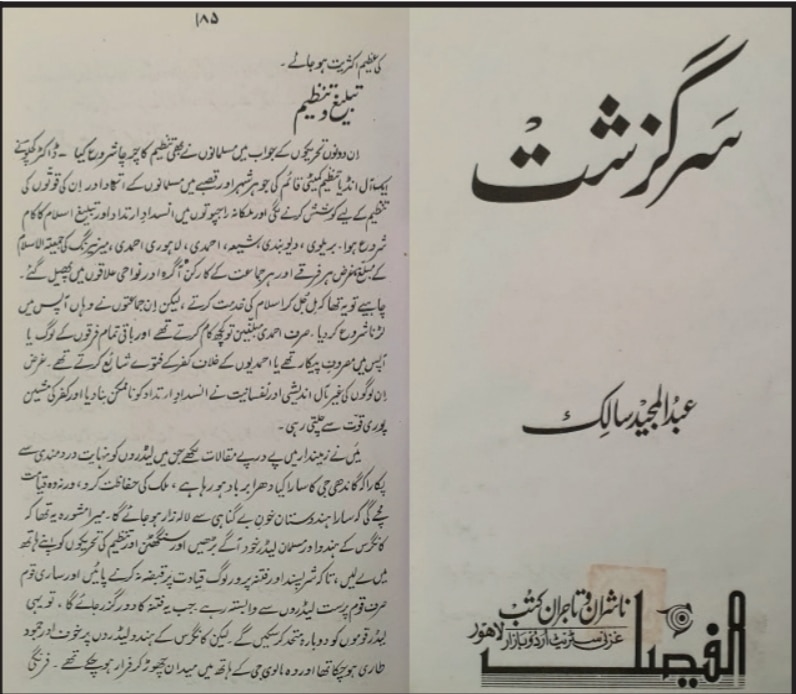
A report by the Criminal Investigation Department of the United Provinces, for the year 1924, stated that in response to the Shuddhi Movement, “the Muhammadan community as a whole welcomed the chance of active opposition as a cohesive force to cement their scattered ranks,” and the “All-India Anjuman Tabligh-ul-Islam (propagation of Islam) was formed to combine the various schools of thought for joint work; this proved impracticable; the Deobandis refused to associate with the Qadyanis, and the Anjuman Razi-i-Mustafa (society to win the favour of the Prophet) of Bareilly refused to work with the Qadyanis, each however worked independently, not without dissensions and not with such success as would have resulted from joint control.” (National Archives of India, Government of India: Home Department, File No. 140-Political of 1925)
On 1 June 1925, a newspaper Ahl-e-Sunnat of Amritsar wrote:
“At the beginning of the fitna of apostasy, there were many [Muslim] anjumans that arrived there to work, but within a few days, those anjumans left the area. On the other hand, Qadianis are very actively working. The Qadianis have controlled Surajpur. Muhammad Ismail wrote in a letter from Agra that the intensity of the Shuddhi [movement] has decreased, whereas the Qadianis are more active now. All [other] anjumans have left the area. […] Qadianis have controlled all the villages. Qadianis are now present in Salehnagar and Sandhan as well.”
On 25 July 1927, Tej of Delhi reported:
“The Vedas are revealed. They are the very first heavenly scriptures and the complete teaching. The Qadianis used to say that the Quran is the Word of God and Hazrat Muhammad is the Seal of the Prophets. As a result of this constant effort, no Christian or Muslim now converts to the Arya Samaj [purely] for religion.”
The Arya and non-Ahmadi Muslim missionaries started to quit their campaigns in the Malkana district, but the Ahmadi missionaries continued the preaching work. As a result, a huge number of Malkana people re-joined the true religion of Islam, and many prevented apostasy. The Ahmadi missionaries continued to work under the blessed guidance of Hazrat Musleh-e-Maudra and spread the beautiful teachings of Islam.
Related Content
- Hazrat Musleh-e-Maud’s services to the Muslim cause: Guiding Muslims of the Indian subcontinent amid religious and political conflicts
- The Simon Commission, First Round Table Conference and Hazrat Musleh-e-Maud’s valuable guidance
- Freedom is the birthright of everyone: Hazrat Musleh-e-Maud’s guidance regarding India’s independence and partition
- The Wavell Plan and Hazrat Musleh-e-Maud’s call for peace and India’s freedom
- The Simla Conference, 1945: Hazrat Mirza Bashiruddin Mahmud Ahmad’s (ra) guidance prior to the conference and response to its failure
- The Cabinet Mission, 1946: Its background and Hazrat Mirza Bashiruddin Mahmud Ahmad’s (ra) guidance
- The deadlock over Interim Government and Constituent Assembly for India: Its background and Hazrat Mirza Bashiruddin Mahmud Ahmad’s (ra) guidance
- May India and Pakistan live amicably: The Partition of India, 1947 and Hazrat Mirza Bashiruddin Mahmud Ahmad’s heartfelt wish

